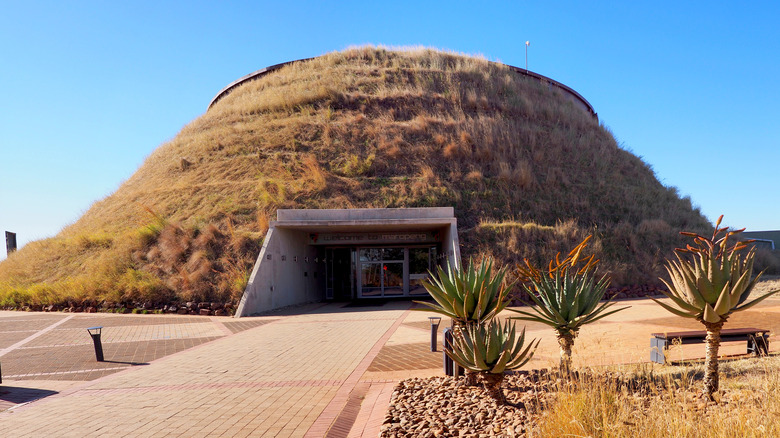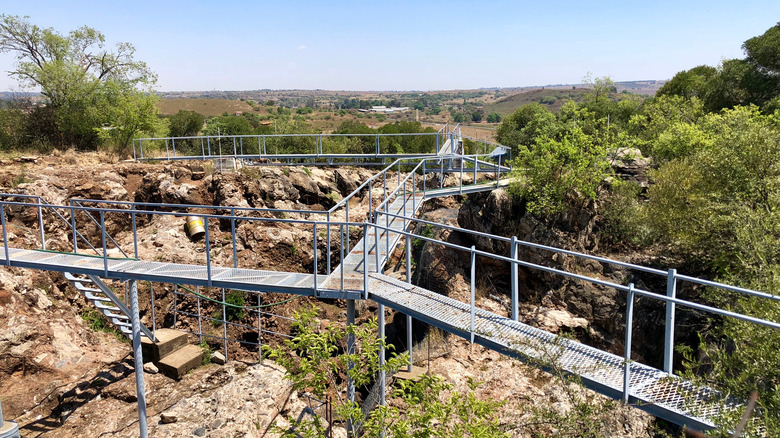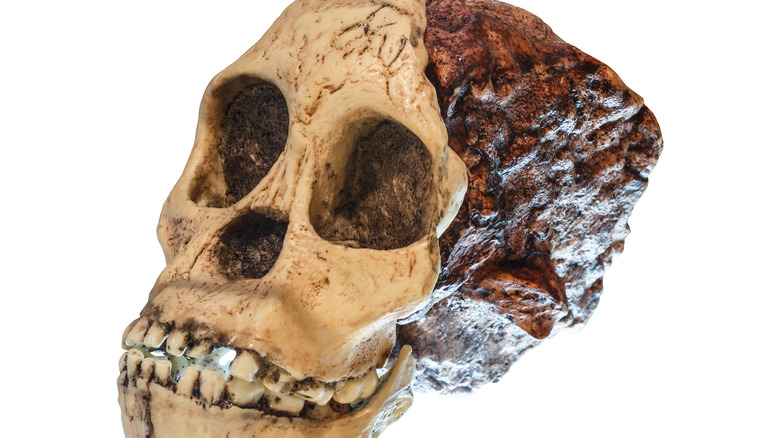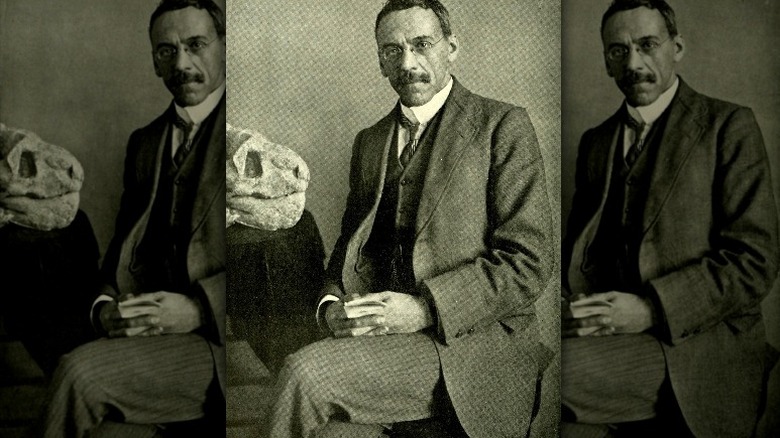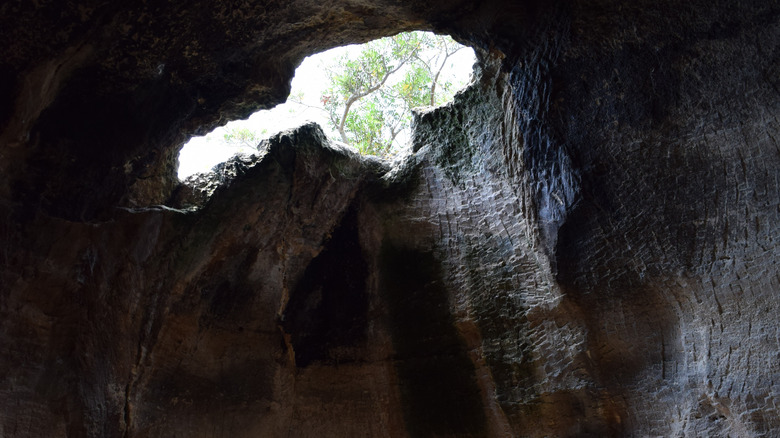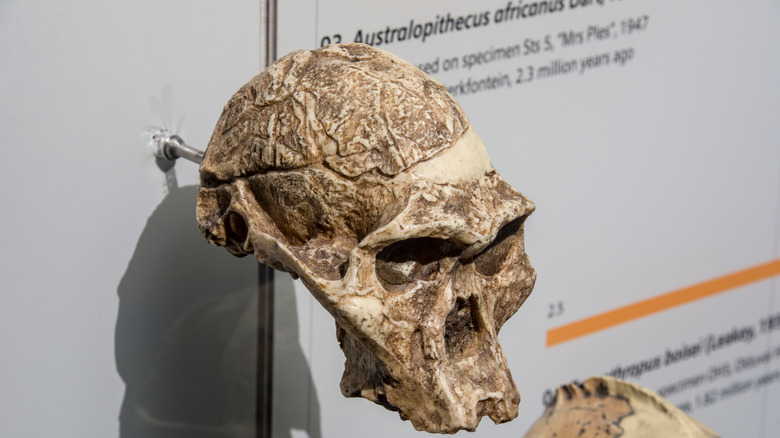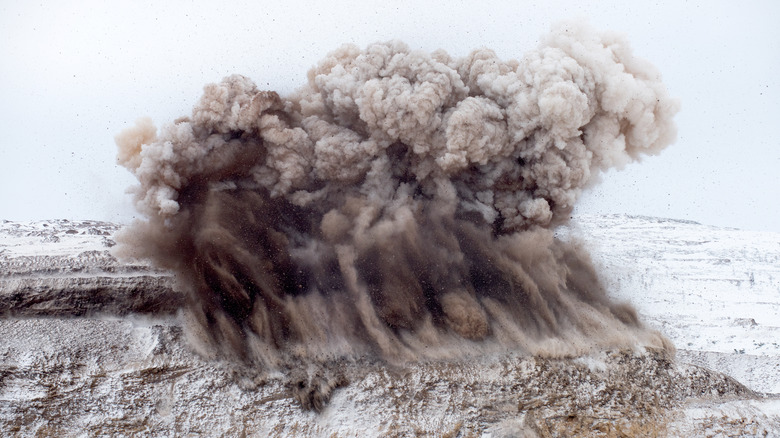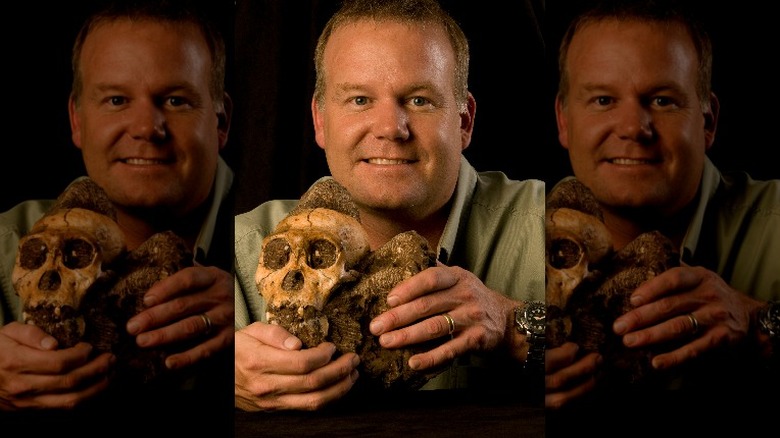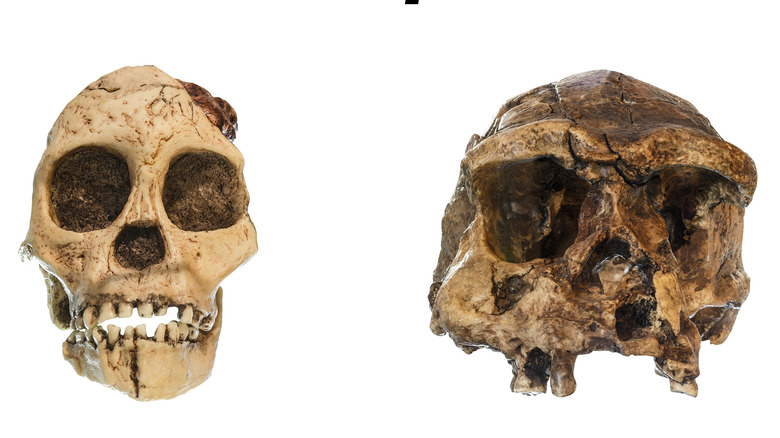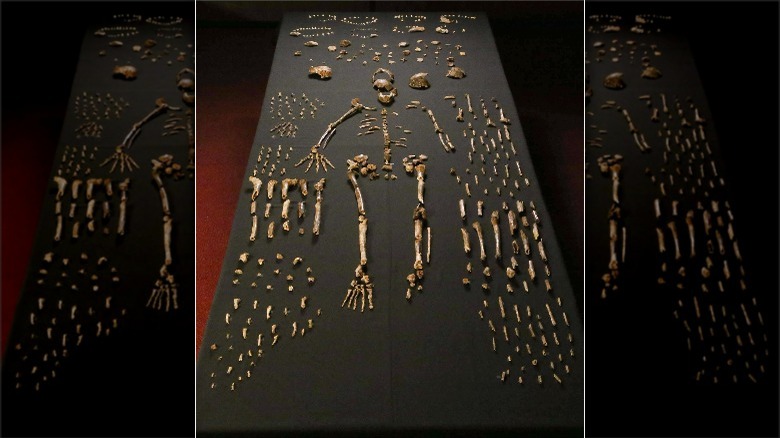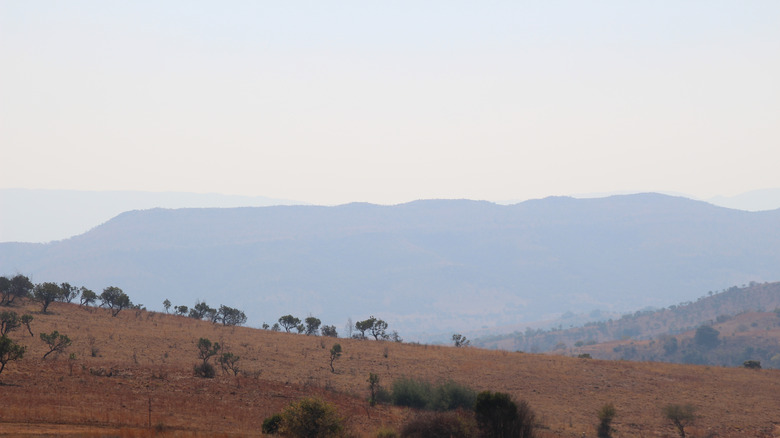The Untold Truth Of The Cradle Of Humankind
The epic story of the Cradle of Humankind really begins over 3 billion years ago, under a warm shallow sea, where the Witwatersrand Basin of South Africa began to form. Exposed to the surface eons later, its thick layers of limestone and rich deposits of gold and uranium, per Britannica, eventually conspired to bring about a long-overdue family reunion, between our earliest upright-walking ancestors and our modern selves.
Millions of years have passed since the first protohumans made walking a regular habit, experimented with — and then controlled — fire, and developed complex societies that buried their dead. It has been thanks to a century of archeological finds in the Cradle of Humankind that we have been able to read at least some of these early chapters in our story, a book yet to be finished. Our old home in the south of the African continent was ancient when our journey began and, not least for the scientists who pore over the fossils it continues to divulge, continues to be unceasingly magical.
A treasure trove of humankind's earliest steps
Located near Johannesburg and covering 180 square miles, according to The Smithsonian, a region of South Africa has since the 1920s unveiled the earliest chapters of humanity. Proclaimed by UNESCO as the "Cradle of Humankind," the area has revealed some major discoveries in human evolution.
It was here, once hidden in rolling valley grasslands dotted with rocky outcrops, that our earliest ancestors, now long extinct, first lived. Some were the small ape-like creatures named Australopithecus (meaning "Southern Ape"), who lived over 3 million years ago and had adapted to walk upright.
Emerging from this earliest branch of our family tree, and even closer to our modern selves, fossilized remnants of the genus Homo (of which Homo sapiens are the only remaining example) have also been found in the Cradle of Humankind. Sporting opposable thumbs, longer-heeled feet, and bigger brains, our direct ancestors lived here before eventually migrating out of Africa. The Conversation notes that fossils of Homo erectus date back to about 2 million years ago, and a newer discovered relative, Homo naledi lived there as well, about 300,000 years ago, according to the Natural History Museum at South Kensington.
The Taung Child was the first major find
In the early 20th century, the area around the South African town of Taung was host to lime mining. Described in the essay, "Raymond Dart and our African origins," by C. K. Brain, as miners tore the earth apart, they would often unearth fossilized bones, some of which would be kept aside for curious scientists.
It was from these miners that Raymond Dart, an anatomist from London, received a box in 1924 containing what they thought was a baboon's skull. On closer inspection, Dart noted that the way the spine entered the skull was more human than ape, suggesting an upright posture. In addition, the brain was large for an ape and had a more advanced structure. He concluded this was evidence of an early proto-human and named it Australopithecus africanus, meaning "Southern ape of Africa."
This discovery, called "the most important anthropological fossil of the 20th century," in "The Fossil Chronicles," by Dean Falk, heralded a radical departure from the conventional belief that modern humans originated in Asia and Europe. The Taung Child's final resting place yielded many more of its brethren over the succeeding decades, giving credence to Africa's place as the birthplace of humankind. In a further dramatic twist, detailed by the Smithsonian National Museum of Natural History, evidence from damage to the Taung child's skull, as well as the type of other animal bones found with it, suggest this unfortunate individual met a grisly end at the talons of an eagle.
It took decades before the significance of the Cradle was globally accepted
Charles Darwin once stated in "The Descent of Man," "It is somewhat more probable that our early progenitors lived on the African continent than elsewhere." But all Darwin had to go on were the anatomical similarities between humans and African apes. As Smithsonian describes, a sense of superiority amongst the European-dominated scientific establishment meant that Asia and Europe were favored as a "more civilized" birthplace for humans (via Scientific American). This was bolstered by the discovery in the 1800s of Homo erectus on the Indonesian island of Java, as well as the Neanderthals in Western Europe.
The 1924 discovery of the Taung Child in South Africa was poorly received, being largely discounted as just an old ape, notes the Smithsonian. The tide of scientific opinion took decades to move towards the "Out of Africa" theory that Darwin had hinted at. Inspired by Dart's publication on the Taung child, in the 1930s, Dr. Robert Broom began his search in Africa for further evidence. After discovering a steady stream of similar fossil fragments, his crowning achievement came in 1947, when in the Sterkfontein caves he found an almost complete adult Australopithecine skull, details the Smithsonian. With perfect timing too, as suspicion over the Piltdown Man hoax was reaching a crescendo and was finally debunked in 1954, per Britannica, ushering in broad acceptance of the "Out of Africa" theory, largely thanks to the Cradle of Humankind.
The region's unique geology helped preserve this ancient story
Anyone who has wandered through a natural history museum or two may be forgiven for thinking the earth is full of fossils. As evidenced by the world not being buried under the bones of every animal with a skeleton that ever died, it so happens that bone usually decays just fine, but fossilization is rare and requires an ideal environment to preserve bones, as described by The White Rose University Consortium. A fluke of geology in the Cradle of Humankind provided just this environment to preserve the fossils of humanity's ancestors there better than other places, considering they may have lived over large areas of the African continent, according to research published in PNAS.
The Cradle of Humankind sits on thick beds of porous limestone, notes National Geographic, through which water can percolate and slowly dissolve, carving out the cave network where a cornucopia of ancient hominid remains are buried, as detailed in a paper in eLife Sciences. Cool temperatures in the interior of these caves slowed the microbial decay of bone and allowed fine sediment, carried in by the trickle of water, to gently cover the remains. This mineral-rich sediment further preserved the bones, leaving them in such great condition and quantity that the discoverers of one of the caves remarked in a PBS documentary how there was a "sea of bone" beneath their feet.
Mrs. Ples (or Mr. Ples) was discovered in the Cradle of Humankind
In the Sterkfontein caves of the Cradle of Humankind, a nearly perfect skull of Australopithecus africanus was discovered in 1947, by Dr. Robert Broom, literally blown out of its long limestone residency by dynamite, as described by the Smithsonian. He initially decided it was a new species altogether and named it Plesianthropus transvaalensis, earning it the nickname of "Mrs. Ples," based on the determination it was more likely female. While the species was later corrected, the nickname stuck, although recent studies have claimed it may be "Mr. Ples" instead, per the Smithsonian.
As the Smithsonian also notes, until this discovery Broom had only found fragmented skulls of the early ape-like australopithecines, but the complete skull of Mrs. Ples, missing only its teeth, added considerable weight to the gradual pivot towards Africa being humankind's birthplace. Indeed, this was the discovery Broom had been searching for since the 1930s, when he was first inspired by the discovery of the Taung child by Raymond Dart, per Britannica. Thus, Broom embarked on a long, determined search for more evidence of these early hominids to sway skeptics of the Africa cradle idea, as described in a biography by South African History Online.
Major discoveries in the Cradle of Humankind have been accidental
The study of ancient human history is littered with serendipity, such as the stone cast by a curious Beduin shepherd boy that clattered into the Dead Sea Scrolls, per the Leon Levy Dead Sea Scrolls Digital Library. Luck accompanied the Cradle of Humankinds's most significant discoveries also, from the Taung Child in 1924, per Britannica, to the recent groundbreaking finds in the Rising Star caves documented by PBS in "Dawn of Humanity."
The first revelations here were cast into the light not by the skilled hands of archeologists but by miners lured by rich deposits of limestone and gold, according to the Cradle of Humankind World Heritage Site. It was their dynamite that blew the Taung Child's skull out of bedrock, not achieving fame until after being scooped up by limestone miners and sent as a curiosity to the anatomist Raymond Dart in 1924, as told in the book, "A Century of Nature." Similarly, as described in the book "Hominin Postcranial Remains from Sterkfontein, South Africa, 1936-1995," the almost perfect skull of Mrs. Ples was originally blown to pieces and needed to be reconstructed.
Even in the 21st century accidental finds have made careers. It was in 2013, as the documentary "Dawn of Humanity" describes, that two amateur cavers were exploring a little-known cave network, known as the Rising Star complex. Moving aside in a cramped tunnel so his fellow troglodyte could squeeze by, one of the cavers decided to explore the offshoot he had happened upon and eventually emerged into a chamber festooned with ancient hominid bones.
Social media was used to great effect to recruit spelunking paleontologists
The Rising Star complex is a recently discovered network of caves, ventured into in 2013, which soon after became one of the hottest sites for finding early hominin remains in modern history, as told in the 2015 PBS documentary "Dawn of Humanity." Of great interest initially was a stunningly beautiful cave, named the Dinaledi Chamber, or the "Chamber of Stars," as reported by National Geographic. Getting inside was no easy task though, and further exploration by skilled paleontologists was needed to examine the delicate remains.
As reported by National Geographic, a specific set of skills beyond a knowledge of archeological bone extraction were needed and quickly, both to access the remains before other amateurs could disturb the find, and so the information could be presented to the world in a timely manner.
The specialists needed had to descend through a technically challenging and claustrophobia-inducing cave system and finally squeeze through a gap only 7 inches wide, as PBS documented. All this and at short notice, so the project's leader, Lee Berger, turned to social media for the task of recruitment — in a true sign of the times, the response was immediate and overwhelming. Within 10 short days, 57 qualified candidates had applied, with 11 being ultimately chosen — all of them women.
Possibly the oldest evidence of deliberate burial was found
Described in an article from The Royal Society as "a most profound innovation of the hominins," deliberate burial is characteristically human. Homo sapiens has been ritually burying the dead as far back as over 78,000 years, according to Nature, but what of our most ancient forebears? Based on the discoveries found in the Rising Star Caves in the Cradle of Humankind, the physical transition from ape to human may have also been marked with the earliest deliberate placing of corpses by the early hominid Homo naledi as far back as 236,000 to 335,000 years ago, according to the Natural History Museum, suggesting complex, cooperative societies.
During excavations in the Dinaledi cave of the Rising Star caves, documented by PBS in "Dawn of Humanity," scientists made two significant observations. The first was the lack of any other animal bones, except for one lonely owl — expected if the bones had been deposited by natural processes. The second, and more telling, was that the age range of the individuals was skewed to either very young or old, with nothing in-between ... much like a cemetery. Together these may suggest that the bodies were placed deliberately by members of their own community, although this is where the comparisons to more recent, confirmed burial end. Therefore the scientists, true to their art, say this is a tantalizing possibility but not certain.
Some of the earliest evidence of the use of fire was found
It is generally accepted that the controlled use of fire played a crucial part in early human history, as discussed in by the Royal Society. Our ancestors gained more from food cooked in it, they made and improved tools with it, and used it to keep predators at bay. Controlling fire likely came first, as making it requires some skill and tools, using sources such as brushfires to obtain a flame that could then be kept fueled and sustained. As the Smithsonian describes, it so happens that our earliest upright steps coincided with a drying of the climate in the region of South Africa that the Cradle of Humankind covers, with open heat-soaked grassland perfect for a passing thunderstorm to set ablaze, 2 million years ago.
In the caves of Swartkrans, fragments of burnt bone, with some showing possible signs of butchery, were found over a wide portion of an excavation in a pattern not consistent with natural brush fires, according to the journal Philosophical Transactions B. Indeed, these scorched bones indicate a hotter and more sustained fire when compared to the periodic, lightning-ignited fires that sweep across savanna grassland, according to Nature and the official Cradle of Humankind public website. From this evidence, it appears people have been gazing into campfires for over a million years.
Various ancestral human species may have cohabited in the Cradle
A common view of the evolution of humankind, symbolized by the infamous "March of Progress" image, is a linear progression from ape to modern human, one neat step forward at a time. The fossil record found in locations such as the Cradle of Humankind paints a more complex picture, as described in Scientific American, with various hominid species coexisting in the same habitats for substantial periods of time, competing for resources and potentially even interbreeding,
From remains found near the Drimolen Paleocave System, scientists have untangled evidence of three distinct species of hominids living in the same place, at the same time, around 2 million years ago, as a report from the Smithsonian details. Australopithecines, small ape-like primates that exhibited human features such as a more upright stance, were already know to exist at this time, though the fossil record indicates they were in decline. But among the evidence was also found a more muscular offshoot of the human family tree, Paranthropus robustus, whose powerful jaws made easy work of its tough plant-based diet. Even more tantalizing were the fossils of what appear to be some of the oldest Homo erectus remains yet found, putting our direct ancestors in the same neighborhood as their own.
A new missing link was discovered in the 21st century
In 2013, during an expedition led by Lee Berger of the University of Witwatersrand, South Africa, into the caves of the Rising Star system, bones of a new kind of hominid were discovered, as documented by the 2015 PBS documentary "Dawn of Humanity." Until then there was a gap in our family tree, another mercurial "missing link" between the primitive ape-like Australopithecines and our more human-like, bigger brained Homo family members.
According to the Natural History Museum, the numerous fossils dated from around 300,000 years ago and bore a combination of the ape-like Australopithecine and the very early human species Homo habilis (otherwise known as "Handy Man"). Even more intriguing were the parts that looked more human — the wrists, hands, and feet, as well as some of its teeth. As reported in National Geographic, Steve Churchill of Duke University remarked, "If you'd found the foot by itself, you'd think some Bushman had died." The partial skulls found however were decidedly not human in size, once encasing tiny brains less than half the size of our own, although the shape was more human-esque. The hands too, while humanlike in proportion, had longer, curved fingers, suitable for climbing trees. It was as if the evolution of the human body was being shaped from the outside in, rather than being adapted for better use by a bigger and more capable brain.
There is a lot more to be discovered
As the Smithsonian explains, the Cradle of Humankind encompasses over a dozen sites in an area of 180 square miles — larger than San Jose, California, per Britannica. In one chamber of one cave system alone, explored by an expedition led by Lee Berger, fossils from 15 different hominids have been found, according to a report by the University of Wisconsin-Madison Magazine. On this expedition to the Dinaledi cave in the Rising Star caves, Berger and his team of researchers believe there are many more fossils to find.
Berger described this more floridly in an interview in the 2015 PBS documentary "Dawn of Humanity": "I had never seen or dreamed of anything like this, the richness of this site. There aren't just hundreds of bones, there are thousands of bones, it's clear ... This is going to take a long, long time." And this was after a single, three-week long expedition.
The discoveries have continued unabated. In 2017, a skull of a Homo naledi child, estimated to be 250,000 years old, was found in the Rising Star caves, as reported by Nature. The child died at 4 years old and was named Letimela ("Leti") by the scientists, meaning "the lost one" in Setswana. Leti's skull is the first to include fragments from the cranium, which aids in determining the shape of the skull and therefore brain. But perhaps more poignantly, Leti allows us to make a more emotional human connection to our past, lost for so long.
